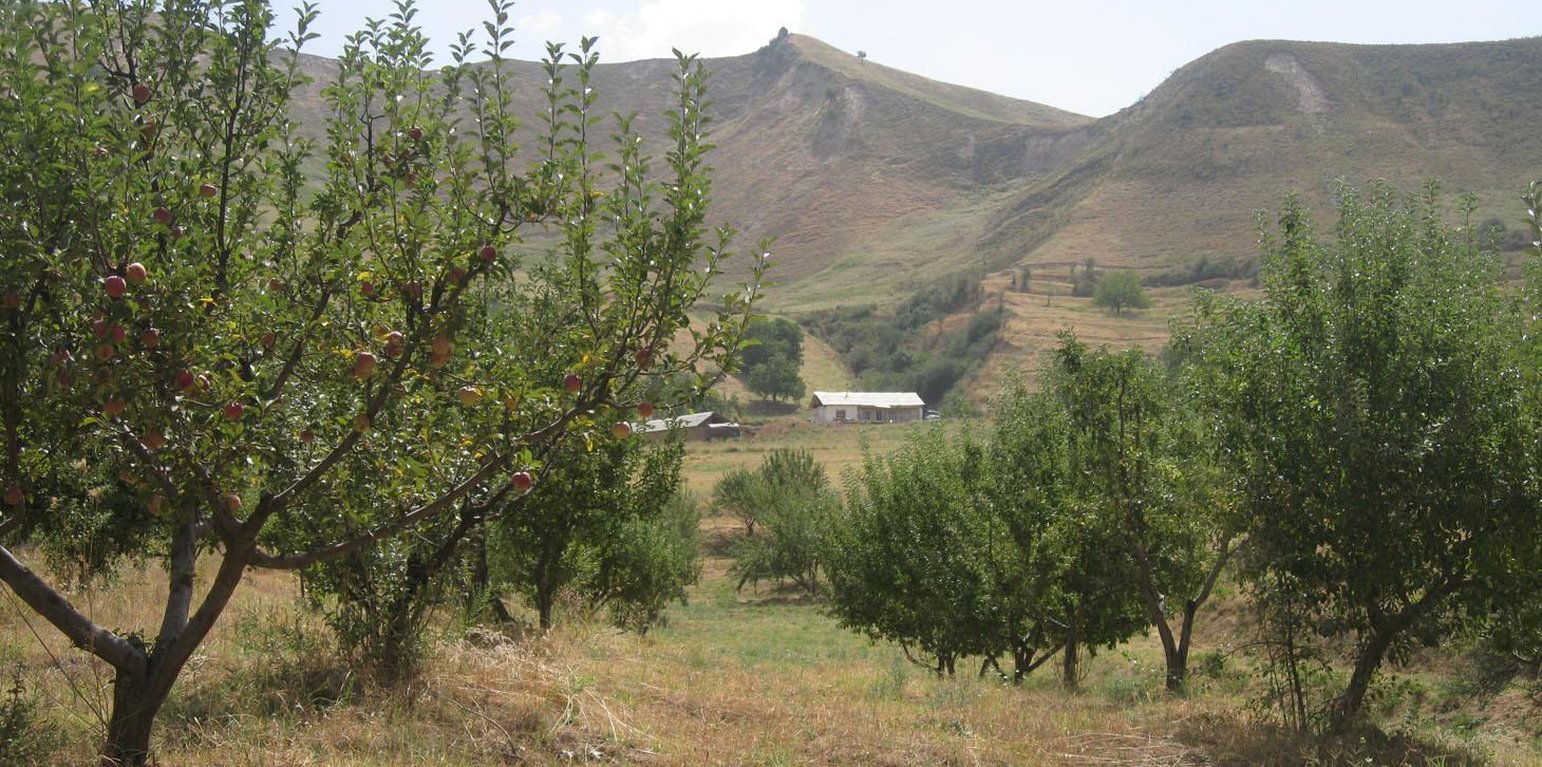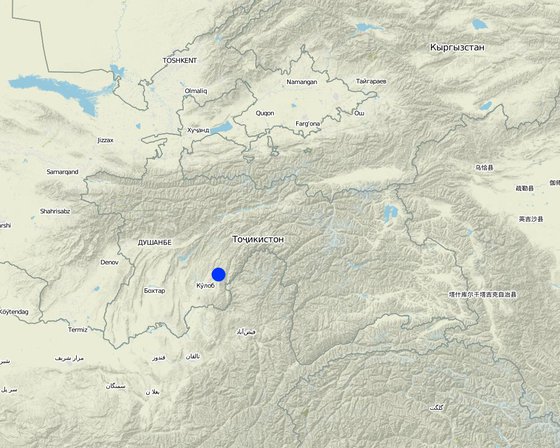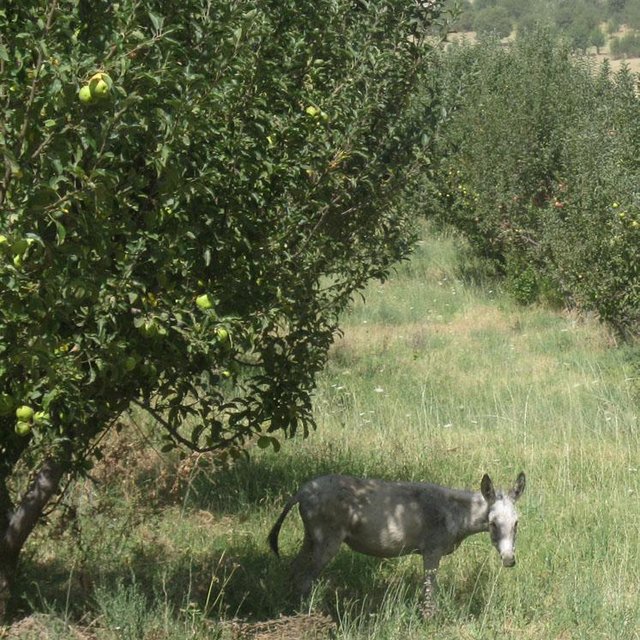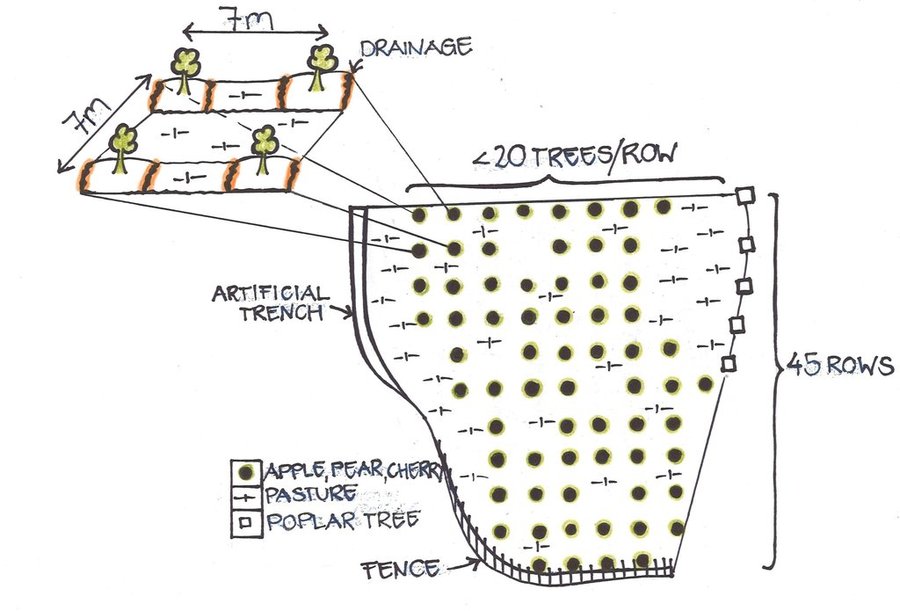



In Soviet times, this area of totally 40 ha comprised terraces and walnut trees in the steep foothills and pastures in the lower and flatter part. After the collapse of the Soviet Era, many similar areas got degraded due to uncontrolled grazing and overuse of natural resources. The area described in this documentation, in contrast, was taken over by a family in 1991. Within the whole area of 40 ha, roads were built to improve the access and 6000 trees were planted, whereof 1200 fruit trees were planted on the pasture, conversing it into an orchard.
At present, the 6 ha of orchard are mainly consisting of three types of apple (white, golden and red), some pear and cherry trees. Several trees must have dried out or have been cut, as the farmer counts currently around 1000 fruit trees. The whole orchard is combined with pasture land. The farmer let his livestock graze in the orchard, and cuts the remaining grass in autumn, if there is still left.
The integrated orchard with pastureland and fodder production is partially fenced to hinder livestock entering his property. Furthermore, the orchard is within the range of vision which allows the farmer`s family to guard it.
The farmer who is managing the orchard today obtained the property of his father in order to continue the family project by his own initiative. By farming he ensures the livelihood of his family. Hence, he felt responsible to progress and improve the quality of life of his own family. The main reason for establishing the orchard within the grassland and to install fences, was to increase productivity of the land, bringin along beneficial effects on soil quality. According to his land users certificate, the main purpose of this land is to provide the local market with food products.
After planting, some of the seedlings were stolen or eaten by livestock from neighbouring farms. Initial labour input in the newly established orchard consisted of getting and planting the seedlings and applying pesticides. The trees are being maintained by pruning. Soil is loosened and drainage provided to increase water infiltration and to protect the trees additionally from parasites. The pasture is grazed by the livestock of the farmer. As the family only has a small number of livestock, grass is cut afterwards and used as fodder. Half of the fodder harvest belongs to the hired worker, the other half belongs to the farmer. The other tasks are executed by the farmer and his family.
The climate is semi-arid with precipitation (800mm totally) mainly during winter and spring time. Altitude is around 1380 m asl. The plot is located at the foothill, with the wider riverbed and fan downstream and overgrazed hills upstream. Bordering with the property from above, a steep slope with a dense vegetation of grafted fruit trees and walnut trees stabilizes the soil.The farmer is living with the family on the property, near the village of Momandion. In the past many livestock from nearby entered the property and grazed there. Through better control and fences less livestock is entering. The property is located directly on the road to Muminabad, the center of the District with a market- 2 km away.Considering the establishment costs of the orchard, the farmer is a fairly whealthy man, nevertheless he had to rely on his family and friends in terms of the working input.The establishment phase was a time and money consuming

Location: Muminabad, Khatlon, Tajikistan, Tajikistan
No. of Technology sites analysed:
Spread of the Technology: evenly spread over an area (approx. < 0.1 km2 (10 ha))
In a permanently protected area?:
Date of implementation: 10-50 years ago
Type of introduction








| Specify input | Unit | Quantity | Costs per Unit (Somoni) | Total costs per input (Somoni) | % of costs borne by land users |
| Labour | |||||
| labour | ha | 1.0 | 194.9 | 194.9 | 100.0 |
| Equipment | |||||
| machine use | ha | 1.0 | 0.7 | 0.7 | 100.0 |
| Plant material | |||||
| seedlings | ha | 1.0 | 207.0 | 207.0 | 100.0 |
| Construction material | |||||
| fence | ha | 1.0 | 124.2 | 124.2 | 100.0 |
| Total costs for establishment of the Technology | 526.8 | ||||
| Total costs for establishment of the Technology in USD | 109.07 | ||||
| Specify input | Unit | Quantity | Costs per Unit (Somoni) | Total costs per input (Somoni) | % of costs borne by land users |
| Labour | |||||
| labour | ha | 1.0 | 383.3 | 383.3 | 100.0 |
| Fertilizers and biocides | |||||
| pesticides | ha | 1.0 | 7.8 | 7.8 | 100.0 |
| Total costs for maintenance of the Technology | 391.1 | ||||
| Total costs for maintenance of the Technology in USD | 80.97 | ||||
As the area of the orchard with pasture is fenced it is not an communal pasture anymore as it was before
From pruning
Products for market leading to higher income, sharing of some knowledge about management of private land enhances dissemination and exchange of information/knowledge.